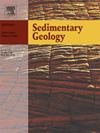格陵兰岛东北部沃拉斯顿福兰群深海裂谷盆地中与水力跳跃相关的冲刷特征
IF 2.9
2区 地球科学
Q1 GEOLOGY
引用次数: 0
摘要
海底陡坡下的超临界高密度浊流往往通过坡底断裂处的水力跃变而转变为亚临界流,造成冲刷和跳水池的形成。在斜坡上,水流头的湍流侵蚀产生的冲刷阵列可以发展成持续超临界流动的斜槽,产生循环台阶。然而,对于粗粒度、深水边坡系统中与水力跳跃相关的冲刷和上游流态的充填,人们知之甚少。本研究考察了格陵兰东北部Wollaston Forland上侏罗世-下白垩世深水同裂谷序列中富含砾岩和砂岩的重力流沉积。这些粗粒沉积物聚集在一个陡峭的水下扇三角洲斜坡上,该斜坡位于盆地边界断裂断崖上。上部坡面为角砾岩和砾岩层,冲刷作用最小,主要为碎屑落落和非粘性碎屑流形成的角砾岩层。相比之下,下斜坡则表现出广泛的冲刷、多样的冲填元素和复杂的层理模式,表明由强烈分层、超临界高密度浊度流造成的与水力跳跃相关的侵蚀和冲填。不对称砾岩冲刷填充物的排列,经常表现出不同的倾斜和横向堆积的分层,可能表明旋回台阶的存在。斜坡底部大量的砾石冲积进一步表明,来自底部惯性驱动部分的砾石被困在由其快速移动的湍流部分雕刻的跳水池中。盆地底部砂岩层的优势表明,含沙湍流在停止之前继续向盆地内流动。我们的发现强调了水流转化和冲刷在塑造海底斜坡和控制深水建筑中的作用。本文章由计算机程序翻译,如有差异,请以英文原文为准。
Signatures of hydraulic jump-related scouring in a deep-marine rift basin, Wollaston Forland Group, NE Greenland
Supercritical high-density turbidity currents descending steep submarine slopes often transition to subcritical flow via hydraulic jumps at the base-of-slope break, causing scouring and plunge pool formation. On the slope, scour arrays from turbulent erosion by the flow head, can develop into chutes where supercritical flow is sustained, generating cyclic steps. However, little is known about the infill of hydraulic-jump-related scours and upper flow regime bedforms in coarse-grained, deep-water slope systems. This study examines conglomerate- and sandstone-rich sediment gravity flow deposits from an Upper Jurassic–Lower Cretaceous deep-water syn-rift succession in Wollaston Forland, NE Greenland. These coarse-grained deposits accumulated on a steep, subaqueous fan delta slope perched on the basin-bounding fault escarpment. The upper slope, with minimal scouring, is dominated by breccia and conglomerate beds from debris falls and non-cohesive debris flows. In contrast, the lower slope exhibits extensive scouring, diverse scour-and-fill elements, and complex bedding patterns suggesting hydraulic jump-related erosion and scour filling by strongly stratified, supercritical high-density turbidity currents. Arrays of asymmetric conglomeratic scour fills, frequently exhibiting variably inclined and laterally accreted stratification, may indicate the presence of cyclic steps. Abundant conglomerate-filled scours at the slope base further suggest that gravel from the basal, inertia-driven part of the flows were trapped in plunge pools carved by their faster-moving turbulent parts. The dominance of sandstone beds on the basin floor indicates that the sand-laden turbulent flows continued basinward before coming to rest. Our findings highlight the role of flow transformation and scouring in shaping submarine slopes and controlling deep-water architecture.
求助全文
通过发布文献求助,成功后即可免费获取论文全文。
去求助
来源期刊

Sedimentary Geology
地学-地质学
CiteScore
5.10
自引率
7.10%
发文量
133
审稿时长
32 days
期刊介绍:
Sedimentary Geology is a journal that rapidly publishes high quality, original research and review papers that cover all aspects of sediments and sedimentary rocks at all spatial and temporal scales. Submitted papers must make a significant contribution to the field of study and must place the research in a broad context, so that it is of interest to the diverse, international readership of the journal. Papers that are largely descriptive in nature, of limited scope or local geographical significance, or based on limited data will not be considered for publication.
 求助内容:
求助内容: 应助结果提醒方式:
应助结果提醒方式:


